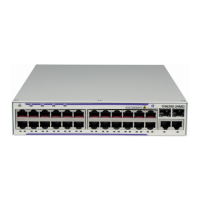System Basics Introduction
Page 222 7210 SAS M, T, X, R6 Basic System Configuration Guide
Note: Please ensure that the SFP or XFP parts used with the SFP and XFP ports support
Synchronous Ethernet.
Synchronous Ethernet using fixed copper ports is supported only on 7210 SAS-D ETR and 7210
SAS-T platforms. The fixed copper ports can be used as a candidate reference (Master) or for
distribution of recovered reference (Slave). If the port is a fixed copper Ethernet port and in
1000BASE-T mode of operation, there is a dependency on the 802.3 link timing for the
Synchronous Ethernet functionality (refer to ITU-T G.8262). The 802.3 standard link Master-
Slave timing states must align with the desired direction of Synchronous Ethernet timing flow.
When a fixed copper Ethernet port is specified as an input reference for the node or when it is
removed as an input reference for the node, an 802.3 link auto-negotiation is triggered to ensure
the link timing aligns properly.
The SSM of Synchronous Ethernet uses an Ethernet OAM PDU that uses the slow protocol
subtype. For a complete description of the format and processing see ITU-T G.8264.
Using Synchronous Ethernet Timing for T1/E1 MDA
Only on 7210 SAS-M and all its variants, the timing recovered from Synchronous Ethernet is
available for use with the T1/E1 MDA. This allows customers to use a stable frequency for timing
the T1/E1 ports in applications where ACR is not suitable for use. Note: Please check the release
notes to know software release in which this feature is available.
Clock Source Quality Level Definitions
The following clock source quality levels have been identified for the purpose of tracking network
timing flow. These levels make up all of the defined network deployment options given in
Recommendation G.803 and G.781. The Option I network is a network developed on the original
European SDH model; whereas, the Option II network is a network developed on the North
American SONET model.
In addition to the QL values received over SSM of an interface, the standards also define
additional codes for internal use. These include the following:
• QL INVx is generated internally by the system if and when an un allocated SSM value is
received, where x represents the binary value of this SSM. Within the SR/ESS all these
independent values are assigned as the singled value of QL-INVALID.
• QL FAILED is generated internally by the system if and when the terminated network
synchronization distribution trail is in the signal fail state.
Within the SR/ESS, there is also an internal quality level of QL-UNKNOWN. This is used to
differentiate from a received QL-STU code but is equivalent for the purposes of QL selection.

